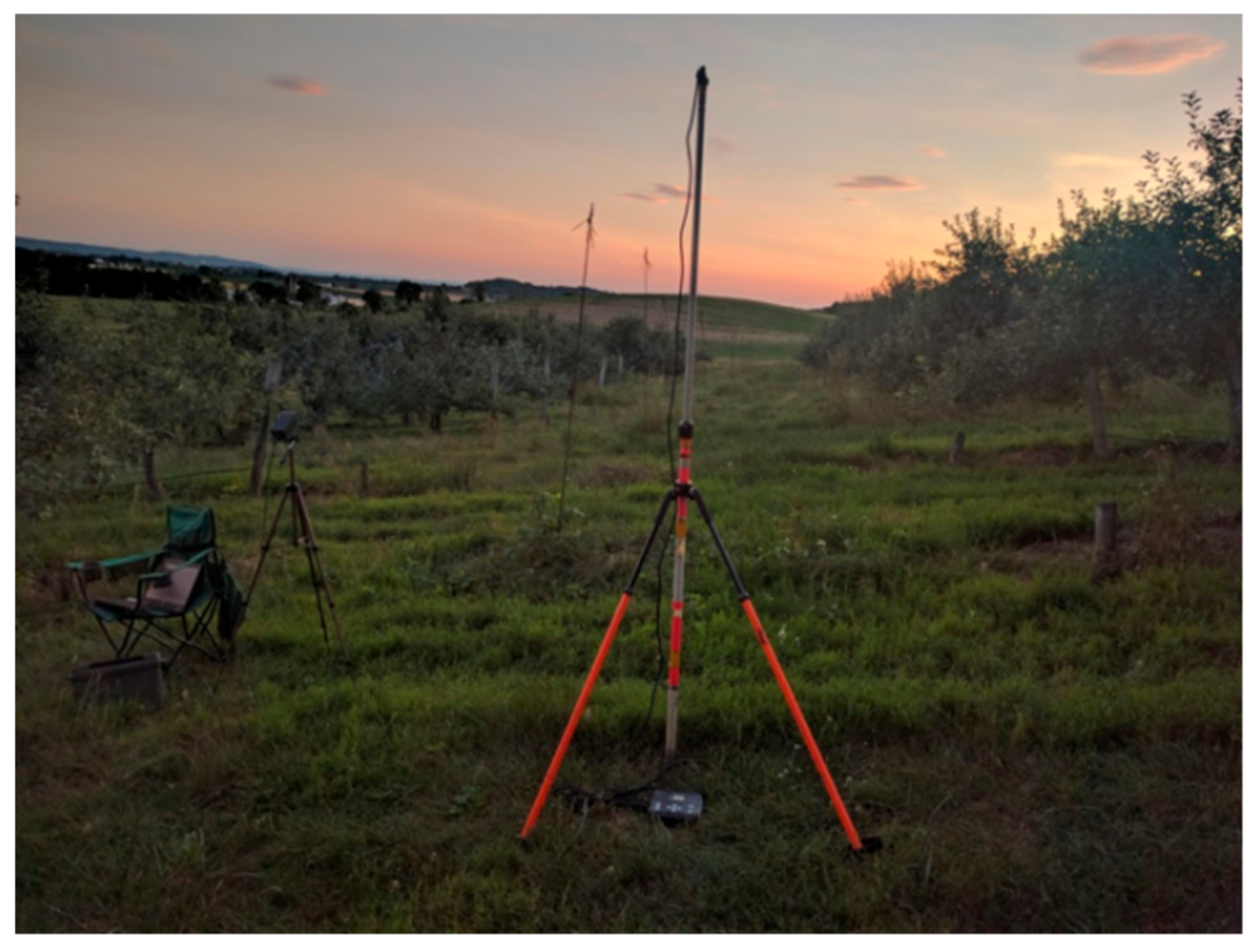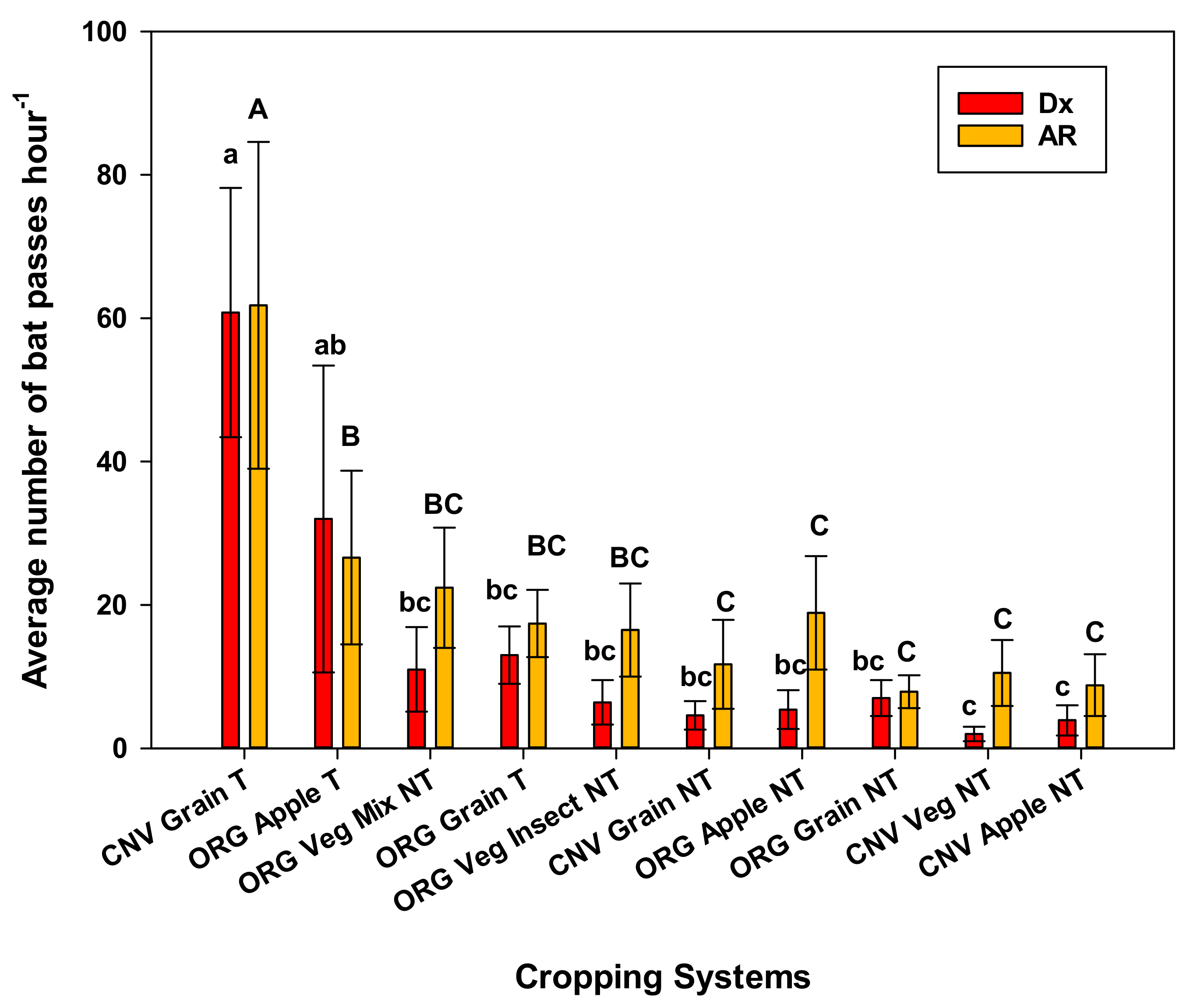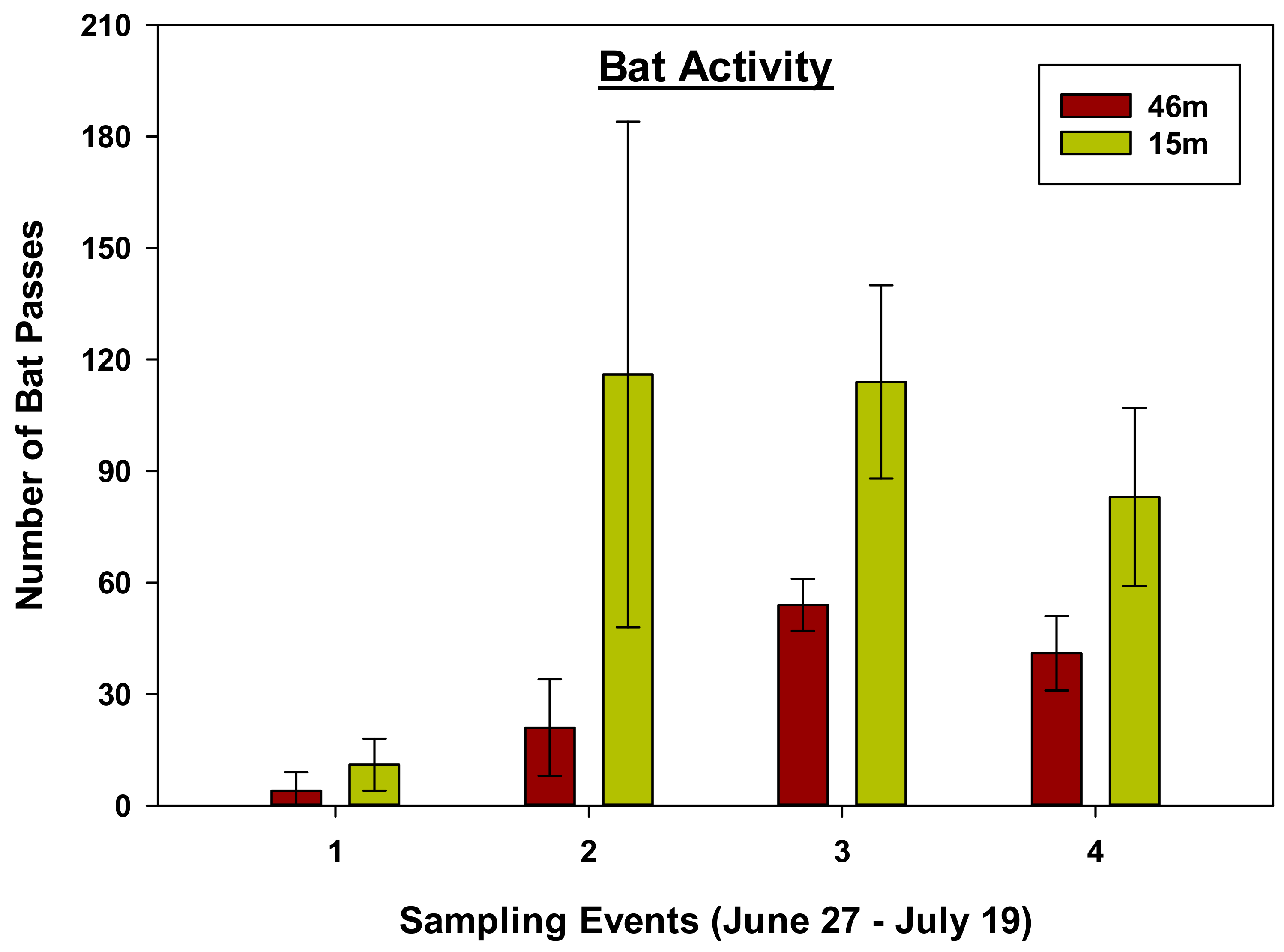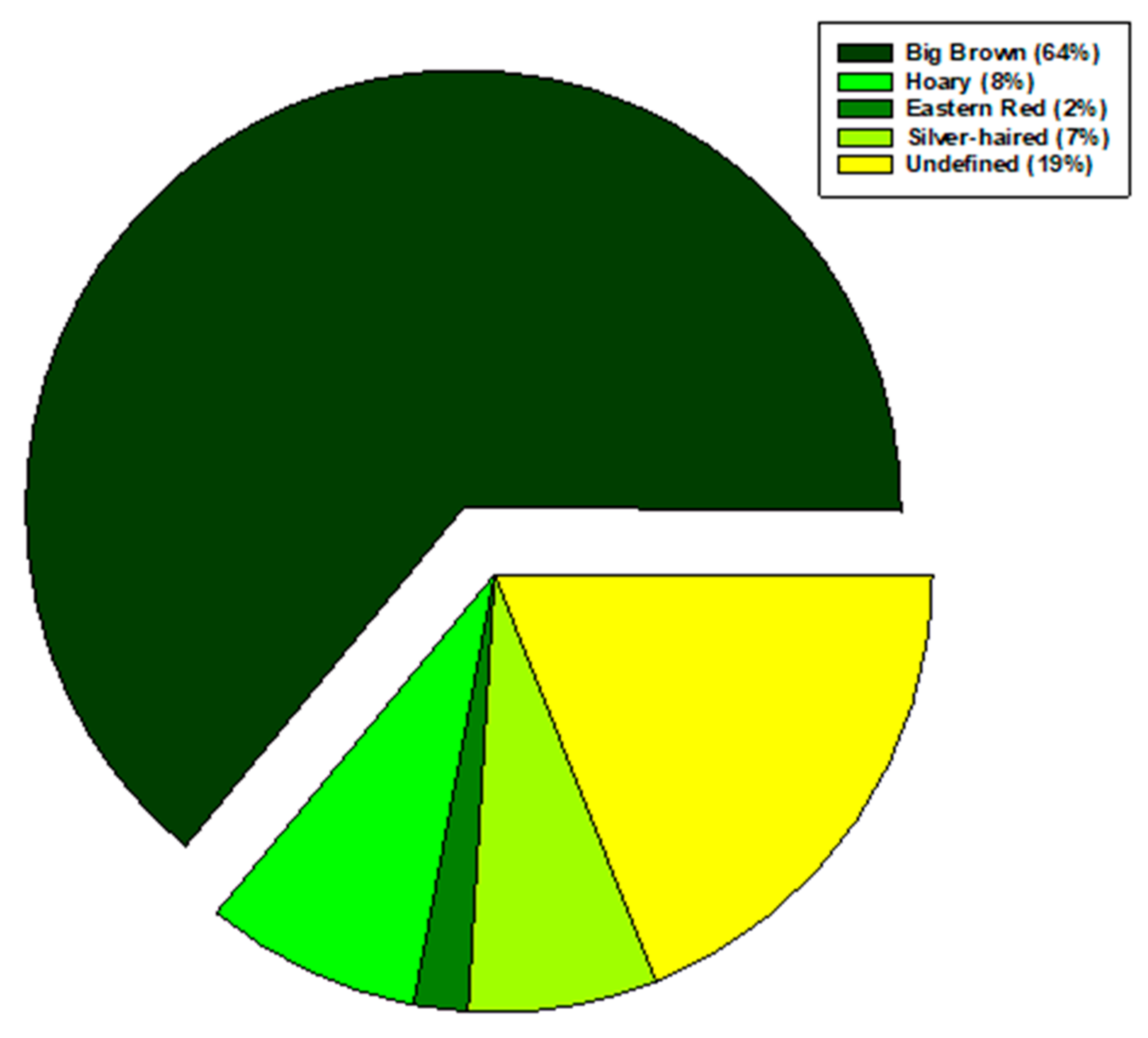1. Introduction
Insects are one of the biggest impediments to agricultural production and organic farming [
1]. Given that organic growers cannot use synthetic pesticides to control pests, they must rely on practices that holistically promote health of the agroecosystem and protect against pest infestations and soil degradation [
2]. Bats (Chiroptera) are an often-overlooked means of biological insect pest management. It is estimated that bats provide between
$3.7 and
$53 billion in ecosystem services in the U.S. annually [
3]. These nocturnal insectivores consume large amounts of agricultural pests, such as weevils, beetles, and moths [
4]. Bats have been known to reduce insect pest densities and damage [
3], insecticide applications [
5], and the economic and societal costs of pesticide applications [
5]. In spite of this, farmers rarely make concerted efforts to encourage bat populations as they are often reluctant to invest in bat boxes or make modifications to their land without solid evidence that bats are helping to reduce pest populations.
Pesticide reduction is critical to human and planetary health and bats can play a critical role in this effort. For example, corn is an essential crop grown worldwide on over 150 million hectares [
3] and adding bats as an integrated pest management (IPM) strategy in corn can potentially have substantial positive effects. It is estimated that the suppression of insect pest herbivory by insectivorous bats is worth more than one billion US dollars globally on corn alone, and bats may further benefit farmers by indirectly suppressing pest-associated fungal growth and toxic compounds on corn [
3]. Further, unlike chemical pesticides that insects can acquire resistance to, insects cannot develop resistance towards bats. Studies have shown that bats’ opportunistic feeding habits can adapt to insect population booms [
6]. A study investigating the diet of big brown bats (
Eptesicus fuscus) during a 17-year cicada (
Magicicada spp.) emergence demonstrated that cicadas were a common prey item found in their diet during the peak abundance of a cicada year compared to a non-cicada year [
6].
Reduction in bat prey items due to increased agricultural intensification and large-scale adoption of genetically engineered crops has also been invoked as a one of the reasons for decline in bat populations [
7,
8]. Higher bat activity and insect diversity on organic compared to conventional farms supports this hypothesis [
9]. Chemical applications to control insect pests often coincide with peak bat foraging period. High exposure to pesticides during these periods may be fatal to bats either from direct contact with insecticides or through accumulation in their diet, which may alter their neurological functions and reduce their ability to feed [
10]. Pesticides that are used in agricultural practices have been found in both tissue and guano samples of bats [
10]. It is speculated that pest pressures will rise in the coming years as bat numbers continue to dwindle, insecticide resistance increases, and climate change brings on irregular booms in insect populations [
11,
12,
13]. For this reason, it is in the interest of farming communities and a priority of the Northeast to support existing bat populations [
14] to enhance biological pest control and ecosystem services. One way to accomplish this is to determine agricultural activities and cropping systems that promote bat foraging activities.
Organic farmers are seeking innovative biologically based tools for their insect pest control toolboxes. Determining how bats use land for foraging can help plan agricultural landscapes to increase their presence, while understanding how agricultural practices affect their roosting and feeding habits can provide farmers with the information they need to take advantage of potential IPM benefits provided by bats. Little to nothing is currently known about the impact of bats on pest populations in the Northeastern United States. Agricultural landscapes encourage bat activities if they provide adequate areas for foraging, corridors for travel and protection, and roosting structures [
15].
Determining how bats use land for foraging can help us plan agricultural landscapes to increase their presence. Bat activity may be encouraged in agricultural landscapes by providing adequate areas for foraging, aquatic habitat, corridors for travel and protection, and roosting structures [
15]. Connectivity of feeding patches and roosts using tree lines are important bat habitats that provide protection from predators and navigation landmarks [
15,
16,
17,
18]. Agricultural practices such as organic farming that promote more crop and ecosystem biodiversity and do not utilize agro-chemicals can support bat foraging [
19]. Farms that can provide natural areas provide both habitat and consistent food source for bats [
20]. Landscape diversity that provides forests, open foraging, and riparian areas can support multiple bat species and their preferred habitats [
21] and riparian buffers are incorporated into many bat conservation plans [
15]. For example, federally endangered Indiana bats prefer wooded areas and having small tree lots and tree lines within an agricultural system as well as riparian areas may provide habitat for this species [
22,
23]. Unfortunately, the past century’s change in agriculture to large scale farms that are mostly monocropped has reduced forested areas, wetlands, and streams that provide natural habitats for bats.
The goal of the project is to fill in gaps of knowledge on the potential benefits of bats in agricultural landscapes, tree lines, the effects of current production systems on bat activity and, ultimately, to help develop plans for farmers to design landscapes that attract bats and provide critical habitat.
2. Materials and Methods
A research project was established in May 2016 to investigate abundance of local bat species and activity differences between different land use management systems, and distance from tree lines. The study was carried out within and around Rodale Institute in Berks County, Pennsylvania (40.5503° N, 75.7222° W). Bat activity was monitored in 10 conventionally and organically managed farms, with or without tree lines at variable distances and different landscape features. Using both a Pettersson D500x (Dx) and AR125 (AR) model acoustic monitoring device (
Figure A1), with microphones attached on top of tripods at 45-degree angles facing the study site, the ultrasonic echolocation calls of bats were recorded at study sites on a triggered recording setting, set to high sensitivity. Recorded data was then interpreted into viable bat calls using Sonobat software. These viable calls recorded as individual sound files, referred to in this study as “bat passes”, were then quantified as bat activity. Each bat call represented one bat pass over the range of the microphone of the Dx or AR. The Sonobat software was used to analyze the bat calls to determine bat species. Each call was reviewed individually to confirm species and to record the presence of feeding buzzes. Through physical observation of bat behavior coupled with the presence of feeding buzzes during recording, bat passes were attributed to bat foraging activity [
24]. Bat monitoring equipment microphones record clear calls within a 30–50 m radius.
The 10 sites were paired to make it possible to monitor 2 sites in one night (Dx-1 and Dx-2 for Dx and AR-1 and AR-2 for AR equipment,
Figure A1). This translated into five nights of monitoring to complete one replicate. A total of five replicates were completed during the season (May–September) in 2016. The cropping systems, both organic and conventional, that were used in this study were grain field (corn and soy), vegetable fields, and apple orchards. The 10 agricultural systems from which data on bat activity was collected are presented in
Table 1.
The recording of bat calls began at sunset May–September 2016. The recording lasted approximately two hours with a change in location to another agricultural system after the first hour. For example, the first hour recorded calls at the organic orchard with tree line then the recording device was moved to the organic orchard without the tree line for the second hour of recording to complete one night of monitoring. For the second night of monitoring, the order of the recording at the sites was reversed. Recording only occurred on nights without rain or wind speeds over 20 miles hour−1. Weather data was collected nightly and included temperature, wind speed, and humidity. We started monitoring on 30 May 2016 to avoid lower springtime temperatures.
In sites that included tree lines, microphones were set up approximately 15 m from the tree line while in sites that did not include tree-lines, microphones were set up approximately 153 m from the closest tree line. Two sets of observers were engaged in setting up the equipment, collecting and processing the field data.
In response to an observation that bat activity tended to increase in systems with tree lines, a follow up study was undertaken in June and July of 2017 to determine how much bat activity decreased in relation to the distance from a tree line. The conventional grain field from the main study was used for this monitoring since it showed the highest level of bat activity. Monitoring began 20 minutes after sunset and only the Pettersson (Dx) detector was used with the same setting used in 2016. The first hour of bat activity was monitored at 15 m from the tree line, while the next hour of activity was monitored at 46 m from tree line. This allowed for both distances to be monitored in the same night. This order was reversed for the next night of monitoring and reversed each night after, to alternate which site went first on each night.
To test the hypothesis that agricultural systems affected bat foraging activities, data on passes representing bat activity at every site were subjected to analysis of variance (ANOVA) using the mixed Model procedure of SAS (SAS 9.4, SAS Institute Inc., Cary NC, 2014) at 95% confidence level. Fisher’s protected Least Significant Difference (LSD) was conducted to separate bat activity between agricultural systems. Data were presented in figures, and tables as the means of three values, unless otherwise specified. All the figures were plotted using SigmaPlot version 14.0 (Systat Software, Inc., San Jose, CA).
3. Results
Looking at the effects of individual cropping systems, the study found no significant (
p > 0.05) cropping system by tree line interaction for bat activity and therefore data were combined for analysis. Results from both Dx and AR were very similar, and moderately well correlated (
Table 2), correlation data not shown) confirming that recordings were equally useful by each device. Bat passes monitored using Dx equipment (Dx-1) were only marginally significant (
p = 0.1,
Table 2) between cropping systems at the first site and not significant for those monitored using AR (AR-1).
Mean bat activity was greatest in conventional grain system with tree line followed by organic orchard with tree line (
Table 2,
Figure 1). However, bat passes averaged between the first and second hour were not statistically different between organic apple orchard with tree line and all the other agricultural systems except conventional mixed vegetable field with no tree line and conventional apple orchard with no tree line (both of which recorded the lowest bat passes). A trend was also observed in agricultural systems without a tree line whereby organic systems without tree line tended to record greater bat activity compared to other systems, even though the differences were not significant.
Broadly looking at the main effects of conventional compared with organic agricultural systems, there was a highly significant farming system by tree line interaction for bat activity monitored using both Dx and AR equipment (
Table 3). Thus, data were analyzed separately by cropping system and tree line. In both organic and conventional systems, tree line had a highly significant effect on bat passes (
p < 0.0001). Bat passes were significantly greater in conventional agricultural system with tree line followed by organic system with tree line. There was no statistical difference between the two systems without tree lines even though organic systems tended to register higher bat activity compared to conventional with both monitoring equipment (
Table 3).
Distance from the tree line had a significant effect on bat activity (
p = 0.0274) with 73.4 as mean bat passes at 15 m from the tree line and 30 passes at 46 m from the tree line when all four counts were averaged (
Figure 2).
Bat species identified by the Sonobat software were very similar between the Dx and AR model acoustic monitoring devices. The greatest proportion of bat species identified were Big Browns (
Eptesicus fuscus) at 64% (
Figure 3). The proportion of other species identified was quite low in comparison, including 8% Hoary (
Lasiurus cinereus), 7% Silver-haired (
Lasionycteris noctivagans), and 2% Eastern Red (
Lasiurus borealis). The software could not identify 19% of ultrasonic echolocation calls recorded.
4. Discussion
Effects of cropping systems: On average, conventional system (with tree line) had 61% and 59% greater bat passes per hour than organic system as detected by Dx and AR respectively (
Table 2). However, organic system without tree line had 67% and 45% greater bat passes per hour than the conventional system without tree line as detected by Dx and AR respectively, although the differences between the systems were not significant (
Table 2). Marginally greater bat activities in organic systems without tree lines than conventional systems without tree lines are consistent with previous studies that reported greater abundance of insects and water sources as reasons for greater bat passes in organic systems than conventional systems [
1,
2,
9]. However, greater bat activities in conventional systems with tree-lines was inconsistent with previous findings [
7]. Variables such as geographical location and sampling protocol can account for up to 80% of the variation in species data [
25]. In the present study, these variables were not standardized as the conventional sites were more than four miles from organic sites. In addition, compared to the organic sites, the conventional site with tree-line had more diverse mature trees and more buildings and farm structures that may have provided more favorable roosting sites, and thus greater bat passes, consistent with Lacki, Hayes and Kunz and Fenton [
15,
16]. While this study did not quantify existing farm structures between cropping systems and may be a question for future studies, the overall significantly higher bat passes under conventional cropping systems compared to organic systems (
Figure 1,
Table 2) may be attributed to the bats’ preference towards presence of tree line than abundance of higher insects that might be present under organic systems compared to conventional systems (discussed in more detail under next section). Also, note that insect abundance as prey items for bats was also not quantified in this study, and thus the hypothesis that organic systems may attract more insects, and therefore greater bat activity is speculative.
Effects of tree line: The presence of, and distance from the tree line had significant effects on bat activity (
Figure 1 and
Figure 2;
Table 2 and
Table 3.). This study showed significant trends in the impact tree lines had on bat activity even in orchard systems. Areas with tree lines, as previously noted, can provide habitat for bats [
15,
16]. Habitat edges as in the interface between a field and forest have also shown an increase bat activity [
24]. Trees may provide vertical structures for connectivity for bats to travel along, valuable roosting sites, and diversity in diet. Orchards themselves can attract bat activity but paired with a native tree line, the activity increases. Significantly greater bat activity in conventional grain cropping system with tree line compared to other systems (
Table 2) can be attributed to food abundance, protection from wind, and/or predator avoidance [
18]. While these variables were not directly observed in the current study, significant tree line effects on bat passes per hour (
Table 3) indicate that the tree line is one of the most impactful features on bat abundance, and flight routes. The strong effect of tree line is also revealed by the number of bats passes at a specific distance from the tree lines investigated in this work as indicated by significantly greater bat passes at 15 m compared to 46 m respectively away from the tree line observed between June 27 and July 19 of 2017 (
Figure 2).
Significantly less bat activities at the beginning of sample collection in June than in July suggest that weather variables such as wind speed, temperature, rainfall, barometric pressure, and relative humidity may have affected bat activities [
9,
26,
27]. Given that the end of spring and beginning of summer is a pre-volant period before offspring (pups) born during that period can fly and forage [
28], volant activity of young bats beginning to fly and forage with adults could have contributed to greater bat activity in July. However, volant activity of young bats was not quantified by this project. The relatively low nighttime temperatures may have reduced bat activity at initial sampling in June consistent with Bender and Hartman and Gonzalez and Bender [
26,
27] (
Figure 2). Wolbert found a significant positive association between bat activity and temperature in a study conducted on the forested ridgetops in the eastern United States [
28]. However, the fact that the average number of bat passes per hour was more influenced by tree lines irrespective of cropping systems studied in the present work (
Figure 1) is a valuable and novel insight of this study. Thus, it is clear that abundance of bats and/or their activity more strongly depends on tree lines than any other factors.
Species composition: It has recently been reported that substantial populations of bats are in decline due to infectious diseases and wind turbines [
11] or unknown causes [
8]. One of the greatest causes of bat mortality in the Northeast is white-nose syndrome (WNS) (
Pseudogymnoascus destructans), which has spread from New York State across the continent and killed over 6.7 million bats [
14]. By collecting species data, we also aimed to see what our current bat populations look like post WNS. The Northeastern U.S. provides a unique glimpse into bat activity due to the fact that the region was at the epicenter when WNS began to decimate bat populations a decade ago. Since the outbreak, bat populations and species dynamics have changed greatly [
14]. The most common species found at all sites in this study was the big brown bat as identified from the recorded data (
Figure 3). Unlike some species of hibernating bats that have seen declines over 90% due to white-nose syndrome, big brown bats show higher survival of WNS compared to the other species due to its species’ traits and hibernaculum preference [
29]. Big browns also hibernate in buildings, sometimes the same ones as summer roosts [
4]. This ability for big browns to hibernate in dry attics or barns can help them avoid WNS. Studies conducted in Europe on European bat species such as
Myotis daubentonii,
M. brandtii, and
M. bechsteinii found greater bat activity under organic farms and organic water habitats than conventional farms and conventional water habitats due to greater quality of feed and water in organic farm types [
9]. However, bats identified in this study are different from most of the European species and seemed to have no significant preference for any particular cropping systems (data not shown).
Given the greater role attributed to big brown bats in this study, it is important to better understand their role in pest management and land use. Previous studies have noted the great potential of big browns to provide substantial ecosystem service to agriculture with over 80% of their diets consisting of agricultural pests such as scarab beetles, spotted cucumber beetles, stink bugs, and leaf hoppers [
4]. Farmers can be both the beneficiary of these services and also play a large role in bat conservation. Maintaining or installing native tree lines, can provide habitat for all species of bats both common and rare. Educating farmers on the behaviors of bats can also equip them with information in regard to sharing farm structures with bats in order to support roosting and even hibernation.









